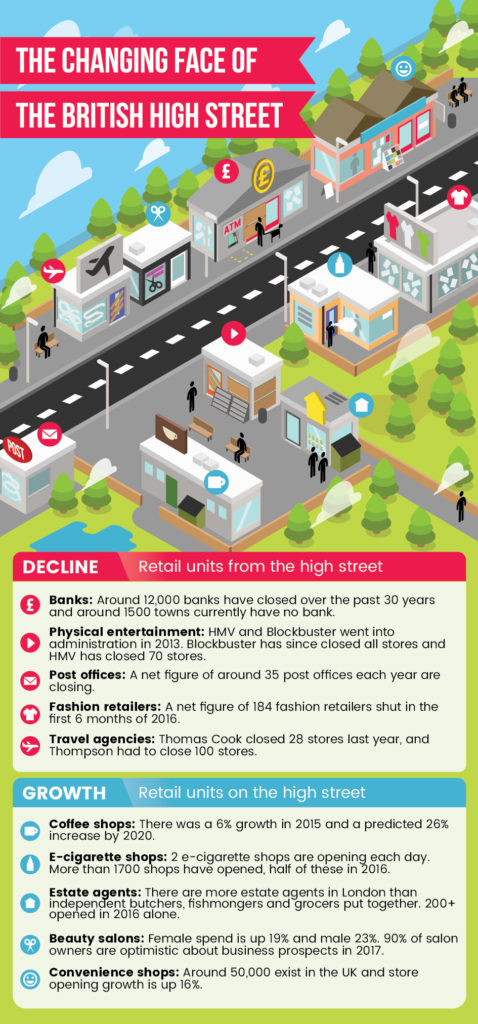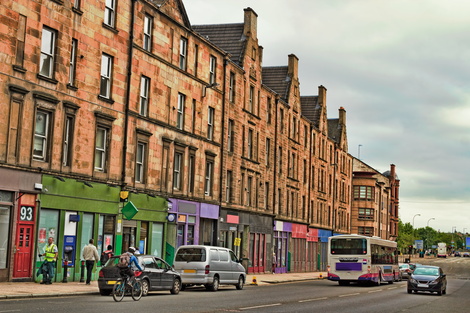The British high street is continuing to diminish.
So much so that it appears that the high street as we know it may soon become obsolete as both independent and chain stores feel the brunt.
In an interview last month, chairman of M&S Archie Norman said that the business was on a ‘burning platform’ and said unless the company changes and develops ‘in decades to come there will be no M&S.’
According to ParcelHero’s David Jinks, between 2020 and 2030 half of the UK’s existing shop premises will have disappeared. 100,000 stores will close, leaving just 120,000 shops on our high street. And that’s because by 2030 e-commerce will account for around 40 per cent of all UK retail sales.
UK online transactions change over the last year

Christmas retail figures fall
ONS retail statistics show that last Christmas’s retail figures, usually the highest, slumped to their biggest fall for over four years, while online sales rose 21.3 per cent. However, there was some rest bite this July as the summer’s heatwave brought consumers onto the high street as online sales fell 0.4 per cent, although this blip probably won’t last very long.
Retail giants fall
In the past 10 years, Brits have seen a number of their favourite shops close their doors. Notably, the 100-year-old Woolworths in 2008, Blockbusters in 2013, BHS in 2016 and Toys ‘R’ Us falling into administration in 2018. The trend has continued with 21,355 retail workers being laid off in the first six months of 2018 alone as Poundworld went into administration. In 2017 the retail worker layoffs’ number was 12,225, according to the Centre of Retail Research.
Jinks believes our department stores are collapsing as the current business model fails today’s shoppers. ‘Alders and BHS will not be the only failures. Of the surviving 200 large businesses, 48 business are already labelled in danger and 53 made a loss in 2016. How long can the sector continue?’
Clothing stores are the latest fashion victims, with Banana Republic even now slipping from our streets, says Jinks. In 2013 alone there was a net loss of 264 fashion stores from our high street. The online fashion industry could reach £36.2 billion by 2030: 63 per cent of the market compared to today’s 21 per cent.
John Lewis and Tesco fighting back
Yet retailers are fighting back through their own internet sites. John Lewis is one company pushing ahead online: 25 per cent of its sales are now through the internet; that’s more than its Oxford Street flagship sells. And Tesco’s revenue is £2.9 billion online, second only to Amazon. ‘In a way this is cannibalism; these sales will be at the expense of companies’ own physical stores,’ Jinks explains.
There is some hope for the future, he adds. High Streets must return to a Victorian model, where shopping is a more social experience. Homes must also return to UK high streets to prevent no-go areas after 6pm. ‘It has already been shown that home deliveries are far greener than shoppers climbing into their cars to visit various stores. We must all learn to adapt to the rise of e-commerce and introduce new reasons for us all to return to our town centres,’ says Jinks.
The future for physical shops lies with technology, says Beena Nair, retail customer engagement consultant at Capgemini. ‘AI, VR and chatbot technologies, for example, will enable customers to engage with brands using conversational UI.’
Peter Watson, MD of digital marketing agency Distract says Toys ‘R Us’ shouldn’t have positioned themselves as a location to ‘go and buy toys’ in the first place and believes giving online exclusivity to Amazon back in 2000 sparked the beginning of their downfall. ‘(Toys’R’Us) should have repositioned themselves as the place to ‘experience’ toys and fun activities,’ he says. ‘This should have included entertainment sections in store, face painting zones and coffee centres for parents.’
Thousands of shops closing a year
Statistics from The Local Data Company found the vacancy rate for shops is currently 12.2 per cent. One in eight shops are currently boarded up, and in the first six months of 2016, 2,656 shops closed on Great Britain’s high streets, a rate of 15 a day. In the first six months of 2018, 1,200 shops run by major chains have closed or could close, more than have opened.
Shoppers continue to be driven away from Britain’s town centre’s by restrictions on parking. Motorists have complained about the rising charges, fewer spaces and spaces that are too small.
Brexit has also pushed an unprecedented uncertainty onto businesses, regarding the future of stocks, shares, interest rates and the value of the pound which may cause a drop in confidence and therefore sales.
According to Onbuy.com’s MD, Cas Paton, it’s a matter of adapt or die for high street retailers. ‘People love the ease and confidence of selling and buying online now. We allow traders to sell stock at a competitive price. It’s also beneficial for the customers as well, considering we are a marketplace, they can compare prices from different retailers. Shops on the high street need to adapt if they want to compete with online retailers and therefore survive in today’s digital age’.
Infographic – The changing face of the British high street – On Buy







